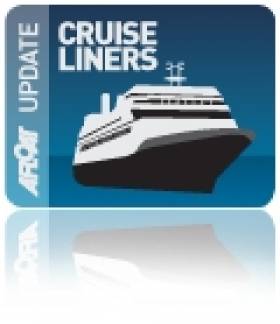Displaying items by tag: Cunard Capital Call
#CunardCapitalCall – Queen Victoria, Cunard Line's elder 'Vista' class cruiseship called to Dublin Port in the late morning today as part of a 7-night 'Lusitania Remember' commemorative cruise from Southampton, writes Jehan Ashmore.
Having sailed overnight from Cobh where the main ceremony took place, this morning she passed Wicklow Head lighthouse at some 14 knots. From thereon she gradually reduced speed on the southern approaches to Dublin Bay.
Even at 90,049 tonnes the Italian built vessel with 2,194 passengers on board the 12-deck vessel has more graceful lines to other similar sized cruiseships.
She picked up a pilot off the cutter Liffey close to the South Burford Buoy.
When she further entered Dublin Bay offshore of Dun Laoghaire Harbour, this is where an anchorage call of her sister, Queen Elizabeth first took place in 2013.
In that same season the Cunard flagship cruise-liner Queen Mary 2 made her first appearance in Dublin Bay and again on that occasion she anchored off Dun Laoghaire.
The massive 151,000 tonnes 'liner' has not visited Dublin Port either, though the largest ever cruiseship is due to visit the port, MSC Splendida of 137,000 tonnes and longest at 333m is set to call to the capital port next Monday.
The record-breaking visit of MSC Cruises 'Fantasia' class cruiseship with 3,600 passenger capacity will also be a historic maritime milestone as this will be the biggest ship of any kind to visit Dublin Port.
Should one or both of the proposed cruise-berthing facilities totalling almost €50m be given the go-ahead in Dublin Port and neighbouring Dun Laoghaire Harbour, it would only be then that even bigger behemoths of the cruise industry will be able to berth within port.
In the meantime, the 294m Queen Victoria was able to turn around within Alexandra Basin. This part of the port is awaiting An Bord Pleanala decision on the proposed €200 million reconfiguration of the west basin that includes the dedicated cruise terminal. The proposed redevelopment would also require significant dredging including the channel leading to the port.
The 'Cunarder' came alongside Alexandra Basin's berth 33. This same stretch lining Ocean Pier within the basin is where MSC Splendida will notably berth 'astern' due to the existing confines of the port layout.
Such sized cruiseships and even larger in addition to increasingly bigger cargoships cannot use the existing turning circle which dictates ultimately the size of vessel using the port.
























































